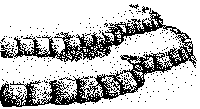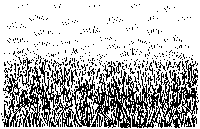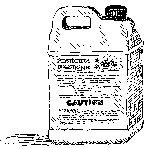|


Related Topics

| |
We rely on reservoir systems, wells, and other sources for our
freshwater. In recent years, our previously plentiful clean water supplies have
been threatened not only by overuse, but also by contamination. Pollutants are
carried down with water soaking through the soil to the water table. Runoff
(water that does not soak into the ground) flows over the surface, often taking
soil and polluting chemicals with it into lakes and streams.
Home lawns and landscapes may contribute to this water pollution when
homeowners apply pesticides and fertilizers carelessly. By using pesticides and
fertilizers properly and only when necessary and following recommended landscape
practices, you can do your part to protect our lakes, streams, and drinking
water for the future.
Return to Table of Contents
-
When diagnosing a plant problem, remember that most problems are not
caused by insects or disease. Severe cold or heat, waterlogging or drought,
lawn mower damage, and carelessly applied herbicides frequently injure
plants. Pesticides will be useless for these kinds of plant damage.
-
If you determine your problem is caused by a pest, identify the insect,
disease, or weed before choosing a pesticide. Ask yourself: Is the injury
severe enough to require control? If so, what options are available? Is
chemical control the best option? Can the pest be controlled by a; pesticide
at this stage of its life cycle? Is there a pesticide labeled for use on the
plant involved and effective against the pest?
Return to Table of Contents
-
Plan ahead to eliminate or reduce storage and disposal problems. Buy only
what you will need for one season. Purchase pesticides in formulations with
minimal packaging, if possible. For example, some herbicides are now
available in a tablet form that can be dissolved in water.
-
Never spray near water or when there is wind. Pesticide can drift directly
into streams or drainage ditches, polluting our waterways. Pesticide may
also drift into unintended areas, damaging desirable plants.
-
Buy and mix only what you will use - unused pesticide is difficult to
dispose of properly. Never pour pesticides down the sink or into storm
drains. If you have extra pesticide mixed, to dispose of it legally you must
spray it on plants listed on the label at no more than the allowable rate.
This means you cannot respray the same area (this would exceed the allowable
rate) and you cannot spray excess pesticide labeled for tomatoes on the lawn
(unless home lawns also happens to be listed on the label). Consult your
Extension agent for advice on disposal of excess or unusable pesticide.
-
Clean liquid containers by rinsing the contents into the spray applicator
when you mix the last batch. To rinse, fill container about one fourth full
with clean water, recap tightly, and shake. Allow 30 seconds for the
container to drain between each rinse. Repeat three times.
Return to Table of Contents
-
Use slow-release fertilizers for most ornamental plants, including lawns,
especially in areas with sandy soil. These fertilizers are less likely to
allow nitrates to wash through the soil into the groundwater.
-
Sweep spilled fertilizer off pavement before it is washed away by rain or
irrigation. Nitrogen and phosphorus from fertilizers have' been associated
with many environmental problems, including excessive algae growth,
depletion of the water's oxygen supply, and suffocation of aquatic life.
Return to Table of Contents
 Because soil sediment makes up most of the pollutant carried by runoff and most
of the phosphates and pesticides entering Virginia's waters are attached to this
sediment, controlling erosion will help control water pollution. Landscaping can
help control erosion by holding soil in place and reducing runoff. Because soil sediment makes up most of the pollutant carried by runoff and most
of the phosphates and pesticides entering Virginia's waters are attached to this
sediment, controlling erosion will help control water pollution. Landscaping can
help control erosion by holding soil in place and reducing runoff.
-
Build terraces or a retaining wall on slopes. These can intercept runoff,
giving water time to soak into the ground, and can make attractive planting
beds. Be aware that altering the soil level near established trees can
seriously damage their root systems.
Return to Table of Contents
 By taking good care of your landscape plants, you can reduce the need for
pesticides that could potentially endanger water quality. Good planting and
maintenance practices can also promote healthy, attractive plants that can add
value to your property. By taking good care of your landscape plants, you can reduce the need for
pesticides that could potentially endanger water quality. Good planting and
maintenance practices can also promote healthy, attractive plants that can add
value to your property.
-
Mulch with shredded bark or other organic material around planting beds,
trees, and shrubs. Mulch helps keep down weeds, protects trees from lawn
mower wounds, helps reduce erosion, and protects roots near the soil surface
from hot, dry summer weather.
Return to Table of Contents
A properly maintained lawn looks beautiful and also helps protect water quality.
Healthy grass needs less pesticide and will be better able to take up
fertilizer, reducing the chance of pollutants washing through the soil and
reaching our water supplies.
-
Mow high and often. Setting your mower at the highest recommended level
for your grass type (2 1/2 to 3 inches for Kentucky bluegrass and fescue, I
inch for, bermudagrass) helps keep out weeds, especially crabgrass, and
makes your lawn more resistant to drought and disease.
-
Fertilize cool-season grasses (Kentucky bluegrass, fescue, ryegrass) in
the fall. Fertilize warm-season grasses (bermudagrass, zoysiagrass) in the
summer.
Return to Table of Contents
|
![]() Gardeners' Corner
Kids'
Garden
Sustainable Garden
Contact Us
Gardeners' Corner
Kids'
Garden
Sustainable Garden
Contact Us![]()




 Because soil sediment makes up most of the pollutant carried by runoff and most
of the phosphates and pesticides entering Virginia's waters are attached to this
sediment, controlling erosion will help control water pollution. Landscaping can
help control erosion by holding soil in place and reducing runoff.
Because soil sediment makes up most of the pollutant carried by runoff and most
of the phosphates and pesticides entering Virginia's waters are attached to this
sediment, controlling erosion will help control water pollution. Landscaping can
help control erosion by holding soil in place and reducing runoff.  By taking good care of your landscape plants, you can reduce the need for
pesticides that could potentially endanger water quality. Good planting and
maintenance practices can also promote healthy, attractive plants that can add
value to your property.
By taking good care of your landscape plants, you can reduce the need for
pesticides that could potentially endanger water quality. Good planting and
maintenance practices can also promote healthy, attractive plants that can add
value to your property.